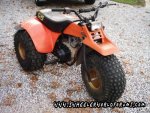My position is, if it's the air pressure that's holding the load up, then it must follow the rule contact_patch_area = weight / tyre_pressure. If it's not the air pressure that's holding the load up, then what is it? Some of it might be the stiff sidewalls of the tyre, but we know that it doesn't take much weight to push those down.
I think it's not purely the "wall strength" of the sidewall pushing down that is supporting the load (in addition to the pressure). There are other geometric forces happening. When a tire is loaded, such that the actual radius to the contact patch is reduced vs. the free radius, you have the vertical wall strength of the sidewall. But you also have to look at what happens to the actual tread surface. This is hard to put into words... The formula for circumference is 2*Pi*radius. Say we're talking a 35" tire. The free circumference is 220". Now, when you load it, and it's aired down, the bottom radius collapses, so the circumference needs to get shorter. But it can't, it's fixed at 220". So, that small piece of tread in the contact patch is actually being compressed into a smaller length. This would end up putting forces into the sidewall to resist the movement.
I'm really having trouble putting this into words. Suffice it to say, there are a myriad of forces in the carcass of the tire, resisting the downward force of the weight, beyond the simple vertical strength of the sidewall.
I can see why the instability of high sidewalls would be something of an issue for a heavy truck. But I'm not immediately sure why the aspect ratio would be important (i.e. why would a wider tyre make a high sidewall less likely to collapse?). I could be persuaded, though.
And I think you're correct. It's not the aspect ratio per-se, but it is the actual height of the sidewall that matters. However, there are some other effect going on related to how the tire sidewall is stretched in or out towards the rim. When the rim is much wider than the tire, the sidewalls are pulled out to meet the rim. This means that side loading is not simply acting in a cantelever fashion on the sidewall. The loads actually become tension loads, because you need to stretch the sidewall in order to get it to deflect away from the rim. That's why you see many performance cars set up this way.
I think the same things happens in truck applications when you have a very wide tire on a narrow rim. The worst case situation is when the sidewall is vertical, and the only way the loads are resisted is pure cantilever bending of the sidewall. So, skinnies are at a disadvantage here.
However, as I've mentioned, relative wall stiffness plays a huge role. You just can't compare stability of wide and narrow tires across different tire models. Tire manufacturers can make VERY stiff sidewalls if they want to. And I think they do on many of the "skinny" E-rated A/T tires many of us choose to run.
For example, my truck came with... 255/55/18's or something like that. These had good stability, because the sidewalls were short, and relatively stiff since they were a "sporty" tire. I traded a guy those wheels and tires for his 16's plus cash, and those 16's had some crappy 255/70/16 P-rated tires on them. It was absolutely TERRIFYING to drive like that. It had very low yaw-stability. When I put my 245/75/16 E-rated S/T-C's on, the stability jumped back up to the same, or maybe even BETTER than the short 18" tires had, even though the sidewall was roughly twice as tall.
I also recently bought a 235/75/15 C-rated Goodyear A/T for my trailer, and was very dissapointed to see how flimsy the sidewalls are.
This is an odd discussion though. When wide tires were starting to be all the rage in the 70's, several magazines did just that and printed the images in the article. For a given tire pressure on the same vehicle, wider tires had a larger contact patch than narrower ones. (I'll see if I can find some of the articles and scan them)
Or maybe I'm missing the discussion point.
No, I think you're completely on-point. You're just providing a counterpoint to the argument that skinny tires have the same contact patch size as a wide tire at the same pressure. It's just not the case.



